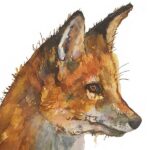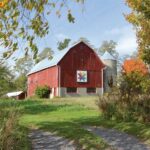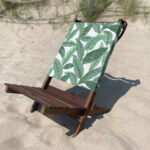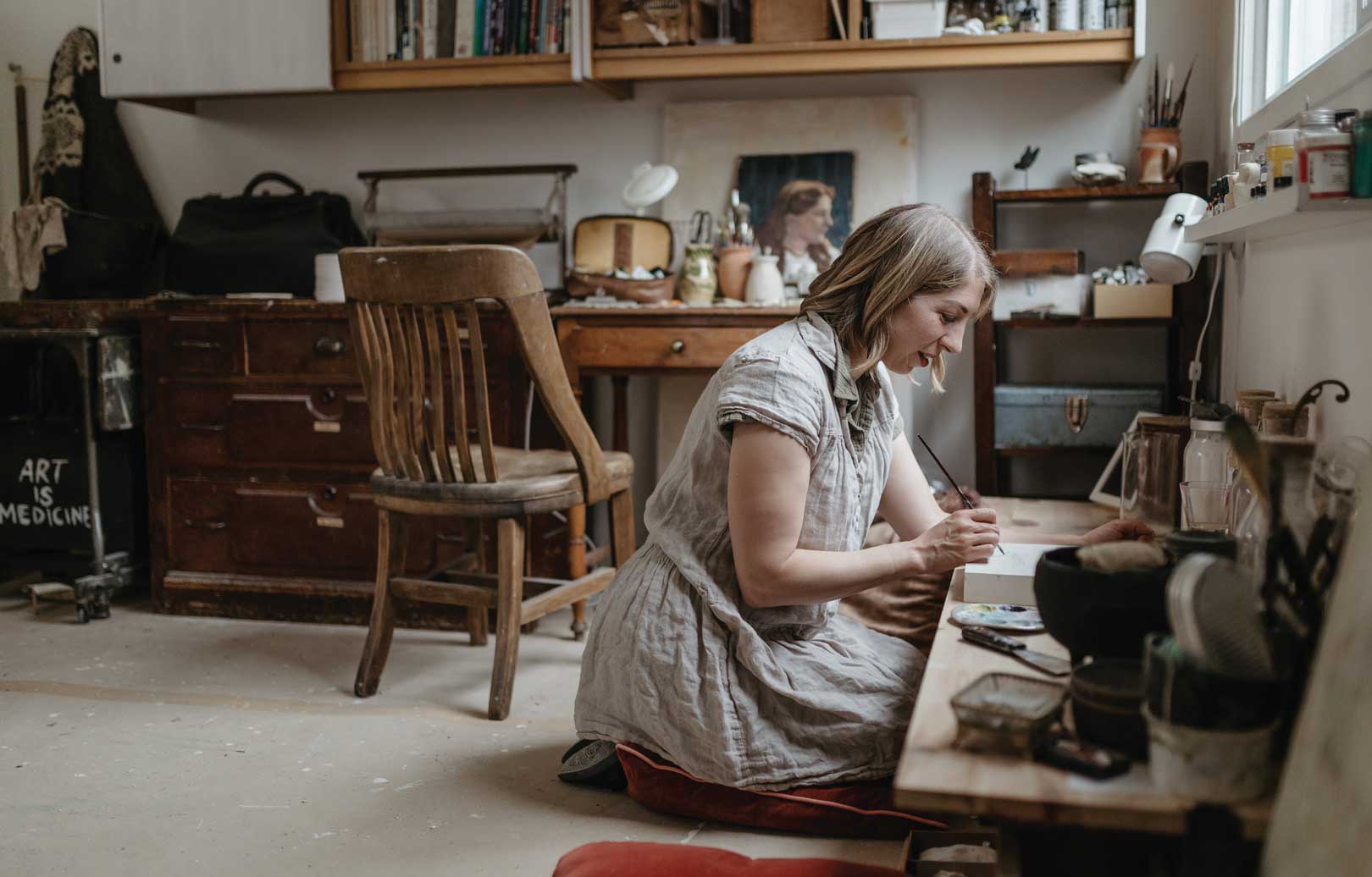
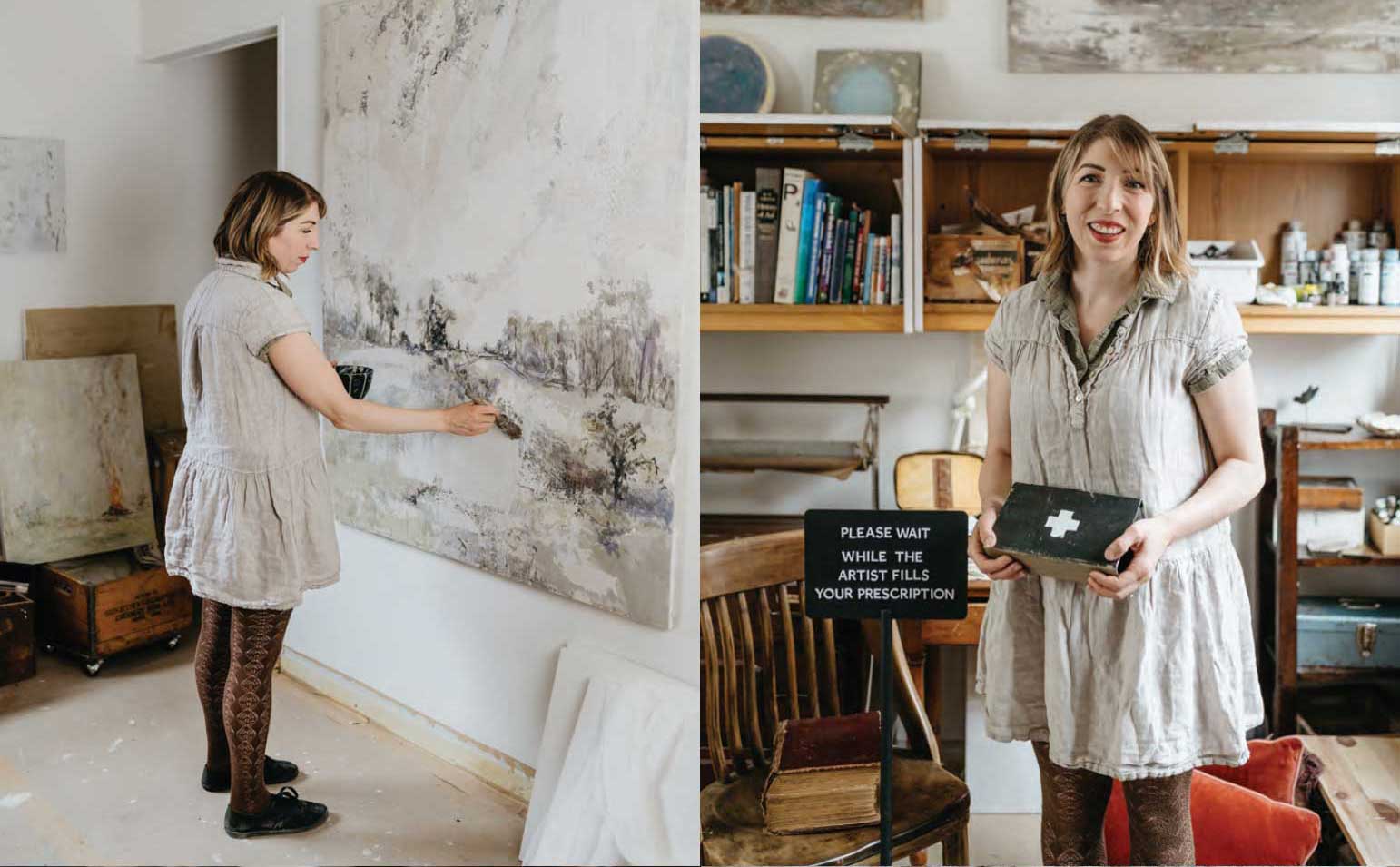
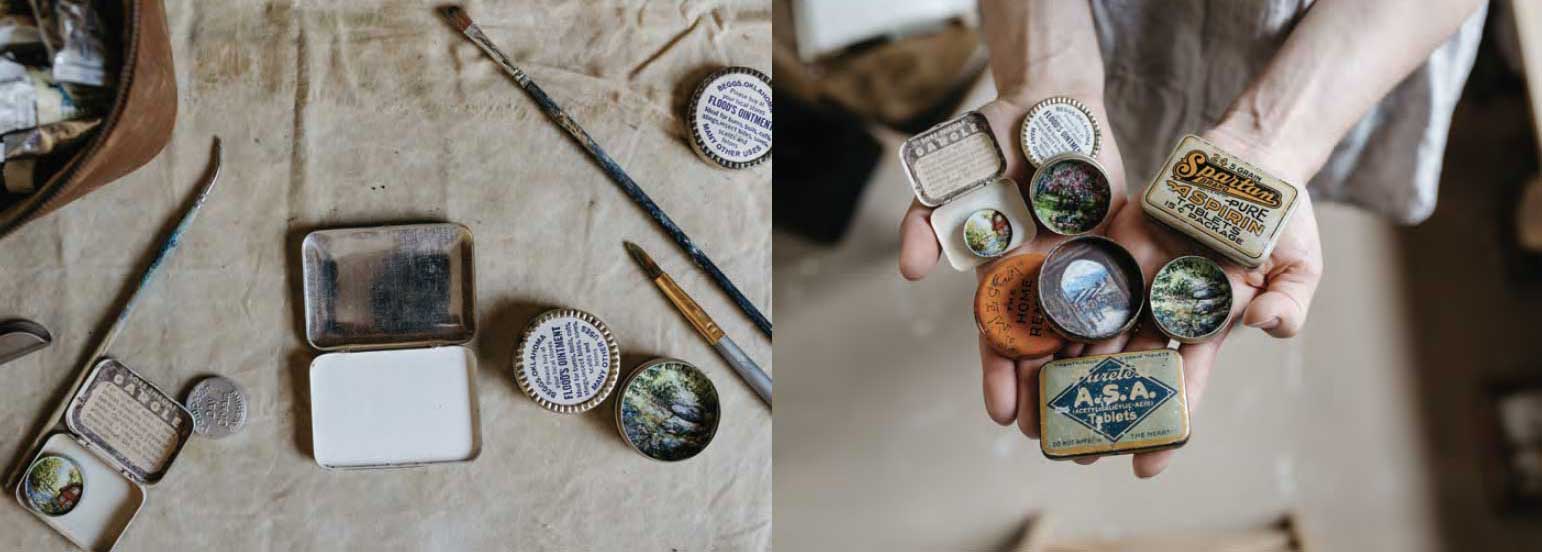
Tucked away in her studio, Shelley Vanderbyl plays with paint and plaster to create works of art – from grand murals to tiny medicine tin miniatures – that become healing touchstones.
Shelley Vanderbyl uses her unique artistic talents to comfort people, to help where she can and to alleviate distress.
“To see the world in a grain of sand,” wrote the poet William Blake, and Shelley Vanderbyl understands. She paints peaceful landscapes so small you can carry them in your pocket, to look at when you want to escape, find a little peace, see another world if just for a moment. Her miniature worlds are painted in oils inside old medicine tins and, like the pills and tonics and salves they replace, their purpose is to help heal. On a grander scale, her frescoes invite viewers to wander in a larger universe.
“Is it presumptuous to think art can help a person to heal?” She smiles her gentle smile. “It’s a big claim, but if something can offer a person hope, it’s worth trying. Hope doesn’t sound like much, until you feel you have none.” There is science behind her ideas, from the phenomenon of pareidolia (seeing faces in clouds and familiar shapes in random patterns) to Attention Restoration Theory, which aims to divert and refocus a troubled mind. It’s the latter that Shelley is riffing off with her pocket miniatures that engage and soothe the viewer in different ways.
Her husband is a military search-and-rescue pilot. It’s no coincidence that Shelley should think about offering relief and comfort to people in trauma, and some of her early work features objects and symbols from her husband’s world, from billowing parachutes to signal fires. She has been painting since she was 15 and, despite having three children and moving frequently from base to base, has participated in dozens of shows and residencies in Canada and Europe. She recently returned from Tunisia where she and artists from Europe and South America created installations in the unfinished rooms of an abandoned hotel. She credits the Swedish curator who invited her to participate with helping her achieve continuity in her work amidst a nomadic lifestyle. Right now, the family lives on Trenton’s 8-Wing Air Base and Shelley paints in a small, spartan studio in town, tucked away upstairs, beside a cannabis shop. I had trouble finding it, but when I saw a humorous little sign outside her unmarked door: “Please Wait For The Artist To Fill Your Prescription,” I knew I was in the right place.
THE MINIATURES
There were a few little vintage medicine tins lying about her studio, but many more are out in public galleries or on loan to hospitals and clinics. The concept is for the images inside to provide immediate relief and immersive therapeutic experiences, to foster fascination and awe in the viewer, to change the narrative of trauma. Stockholm’s Public Art Commission purchased a collection for the Karolinska University Hospital, that city’s largest, most modern health complex; others are kept in portable “first aid” boxes in smaller clinics in Europe and Canada, and, of course, in people’s pockets. A Syrian curator wants to include the tins alongside writers and artists exploring the effects of war. Shelley would love to have them available to patients in hospitals closer to home but says, “It’s difficult making contacts when we move so often.”
When she painted her first medicine tin miniature in 2012, it was not about bringing relief. It was more about making someone laugh. “We were stationed in Moose Jaw and I ran a little antique shop from my studio. People would bring me old things to buy and sell, and someone brought in a bunch of these vintage medicine tins with little promises and slogans on them. I loved them. I first painted one for a fellow artist’s 85th birthday. He was a muralist who worked on a grand scale, painting on the sides of those huge grain silos, so it was a cheeky gesture to give him the smallest piece of art I could do, one he would really have to peer into,” she laughs.
Then they visited a friend with post-traumatic stress disorder, PTSD, who told them of a painful experience. She’d been summoned to a meeting in downtown Vancouver so authorities could assess whether she still needed to be on disability. “She had to travel from her quiet country home into this noisy, unfamiliar and frightening alien environment, and by the time she found the office she was feeling very stressed. Then she entered this small, airless space where the carpet was red, which triggered her condition.”
The concept is for the images inside to provide immediate relief and immersive therapeutic experiences, to foster fascination and awe in the viewer, to change the narrative of trauma.
Shelley shakes her head. “I could imagine how trapped she felt, how horrible. As an artist, my memories are strongly visual, so I understand that to be stuck with images you can’t get rid of must be hell. I thought how it could have helped if she had been able to replace the disturbing images with something soothing.”
Shelley then asked herself, “If what someone has seen can break them, can an image be part of their healing?” She began to explore and research the idea of giving someone an object with an element of fascination and distraction, allowing their cognitive/directed attention to rest. “By creating a space that seems impossibly tiny and detailed and pleasing inside a little box, we can trigger the brain into a sensorial mode of fascination.”
She welcomes input to her ideas and designs, and over the years she has refined which images are most effective. “My goal is to paint as intricately and delicately as possible while choosing scenes with depth to allow the viewer to feel as if the “impossible” exists, that the area inside the tin is no longer an enclosed space but a doorway opened. The minuscule size means you have to concentrate, but they are images a person can take anywhere in their pocket and bring out as needed.”
I studied them, some of them quite battered, held them in my palm and was fascinated. One was barely an inch in diameter, and when the lid came off it really did feel like a portal to another world.
THE FRESCOES
I had come to talk about painted medicine tins, but I was discovering there’s a lot more to Shelley Vanderbyl’s work. As I sat dripping rainwater onto the floor and sipping a mug of hot tea, I found the mere presence of Shelley soothing. She has a face you might find in a da Vinci painting, a soft voice and a gentle smile. She is clearly compassionate, but I learned she is a fighter, too. Diagnosed with breast cancer, she fought back, immediately choosing aggressive surgery and continued the fight through a second diagnosis and treatment. Today she is clear, but she knows firsthand about despair and hope, trauma and comfort.
Dominating her small studio is a big pale fresco, created using plaster that she layers, scrapes back, carves and paints. Her large-scale abstracts draw in the viewer in a different way. “I try to find a balance between giving people enough guidance that they feel they can enter into the painting, then releasing them to wander about inside it. There’s just enough realism to…” she trails off, leaves the room and returns with a shallow drawer filled with rubble. It’s pieces of plaster from a lath and plaster wall.
“I salvaged these from a reno project. I loved the history in them, beautiful marks and textures and image transfers from the old wallpaper. I kept gazing at them the way you look at clouds.” There’s that pareidolia again. “I tried tracing around what I thought I saw and was going to use them as reference for my painting. Then I thought why not try some plaster studies?” In a delightful twist she confides that she was once a drywall taper and plasterer. “Back then I used to notice these things. ‘Ooh! There’s an interesting mark!’ But it was my job to make it white, make it smooth, make it all go away. Now with nobody telling me to ‘finish the job,’ I could experiment.” She was pleased with her first attempt, but totally crushed when she hung it and watched the whole thing delaminate and slide to the floor. “Like an avalanche,” she recalls. “It was supposed to be redemptive for me, but it failed.” She picked herself and the mess up and began researching how to make it work, melding old and new technology and ultimately achieving a body of work that is lauded for its calming, contemplative effect.
Shelley is driven by a desire to reach people, to help where she can, to acknowledge and alleviate distress through art. She finds wonder and awe in many things and has long been inspired by signal fires. She is exploring the power of fire, especially after an arson incident in Comox B.C. that could have destroyed her work. “Someone set a fire by the wall of the gallery I was showing in. I lost my space; my work was covered in ash.” She met the challenge head on. “I decided to use fire to build, rather than destroy.” She smiles that smile again. “Luckily plaster has fire-resistant qualities. The same gallery arranged for me to do this performance: I set fire to pieces of cheesecloth and let them creep slowly across my paintings, across the plaster, burning it into shapes.” The gallery filmed the performance and exhibited the mesmerizing video alongside the actual artworks.
Shelley showed me a small circular fresco with the word HELP scorched into it by fire and string and the artist herself. As I left the studio and stepped out into the rain, I had small images and big ideas in my head, and warm words, too: art and heart and help and hope.
Story by:
Janet Davies
Photography by:
Christine Reid
